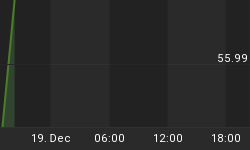The June rally in gold has inspired another flurry of predictions saying that the decline really is over this time. Until now, we have consistently written that we expected the downtrend to continue, and that remains our primary scenario, but this week we are bringing forward an alternate analysis that describes how the low could already be in. We cover both scenarios below, as well as methods to identify which one is actually unfolding.
The important price action for determining the next trade can be seen best on daily charts, so they are the focus of this article. For context and a longer-range price path, readers may refer to the monthly chart and weekly chart that are available in a concurrent post at our website.
Our primary scenario remains that gold prices have been going down in a large, impulsive "A" wave since the 2011 high. In this view, price is now tracing out the fifth and final of the subwaves in the decline, and that fifth wave is taking the form of an ending-diagonal, as shown on the first chart below. Factors favoring this interpretation include:
- The larger count of five waves down appears "correct" in form and proportion.
- On monthly and weekly charts, price has behaved well with respect to channel boundaries that would normally be associated with an impulsive wave.
- The dominant 64-week cycle in gold price calls for a low ideally in October 2014, which would give the ending-diagonal pattern enough time to run its course.
The first daily chart below shows the form that an ending-diagonal pattern probably would take, considering price action from spring 2014 and going forward. The overlapping five-wave series should stretch into autumn. In this view, price should complete wave (ii) of the diagonal by making one more small high in coming days, thus moving into the resistance area highlighted on the chart. After that, price should fall decisively in wave (iii) of the diagonal.
Traders should watch for the following conditions to verify that the primary, near-term bearish scenario is working:
(1) Price ideally would fall away from the resistance area of $1,327 to $1,335. At most, price should not exceed the 76.4% retracement of wave (i), which is near $1,357.
(2) After falling away from resistance, price should cut rapidly through what would otherwise be considered as retracement levels of the June rally. In particular, price should cut through the 38.2% retracement of the recent climb and should keep falling. Fibonacci measurements of the June rally should have little relevance if price were indeed falling in the third leg of a diagonal.

The alternate scenario, which allows for the low already to be in, treats the choppy decline from March as a rather unattractive five-wave impulsive move. This can be seen on the second daily chart below. The main consideration in favor of this view is that wave (v) of the decline has an almost exact 61.8% Fibonacci relationship with wave (i).
In both of the scenarios described here, we would expect some kind of five-wave move down from the high labeled as [iv] in March 2014. The first scenario, shown earlier, involves an ending-diagonal pattern. The second scenario, while offering a complete five waves down from March, fails to provide a final lower low (i.e., below the lows of 2013). A completed five-wave pattern that stops too early represents a type of Elliott wave truncation -- something that happens only rarely.
Traders should watch for the following conditions to determine whether the alternate, bullish scenario (truncation) is working:
(1) Price could rise substantially above the resistance areas shown on the first chart before putting in a meaningful retracement, or (2) Price could fall from nearby resistance but stop falling at a Fibonacci retracement level for the June rally. Since Elliott wave truncation usually occurs only when there is a great deal of pressure for the market to change direction, the initial move out of the ending pattern should be swift (as we have seen in June), and retracements should be shallow. If the market were to rally again from a 23.6% or 38.2% retracement of the June move, it would signify that the alternate scenario probably was working.

















